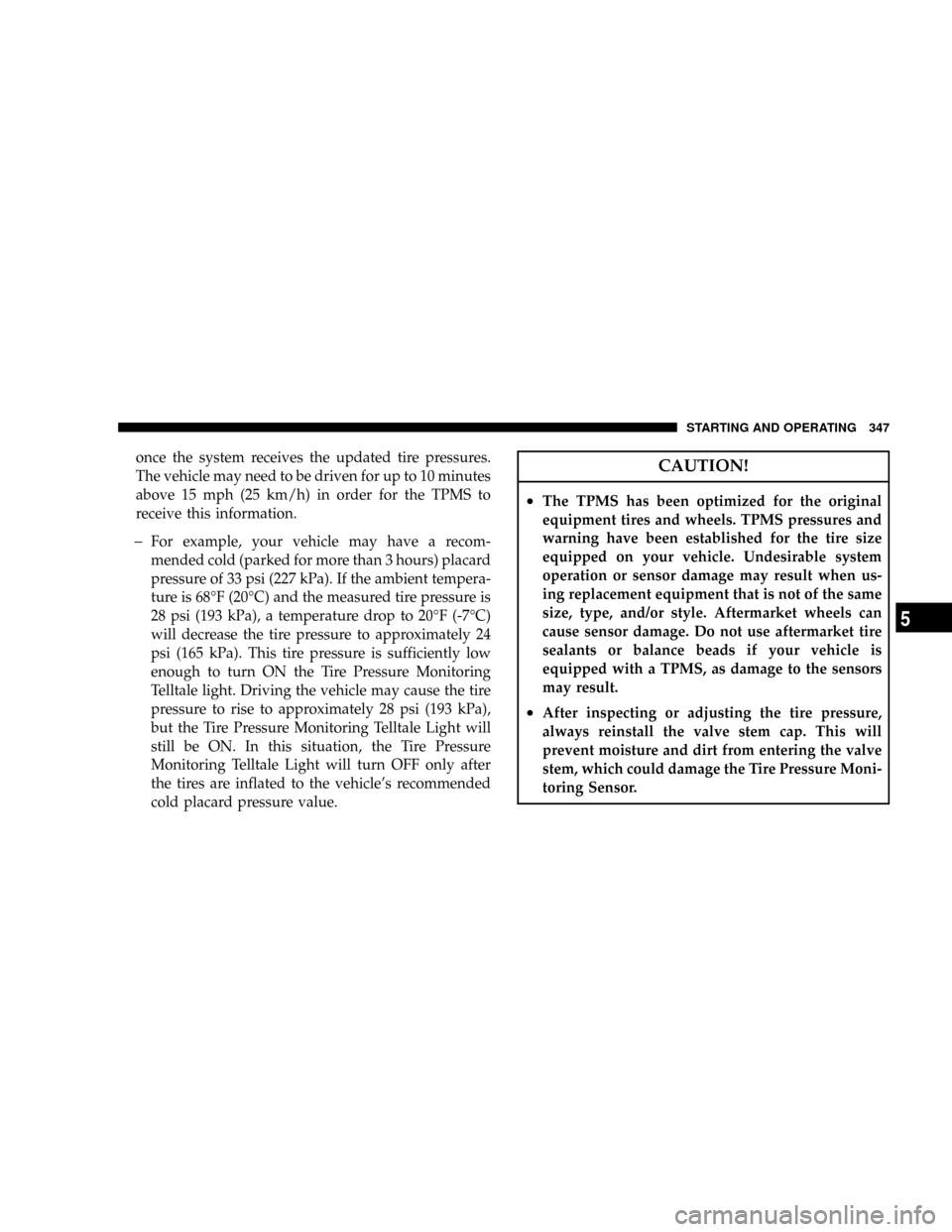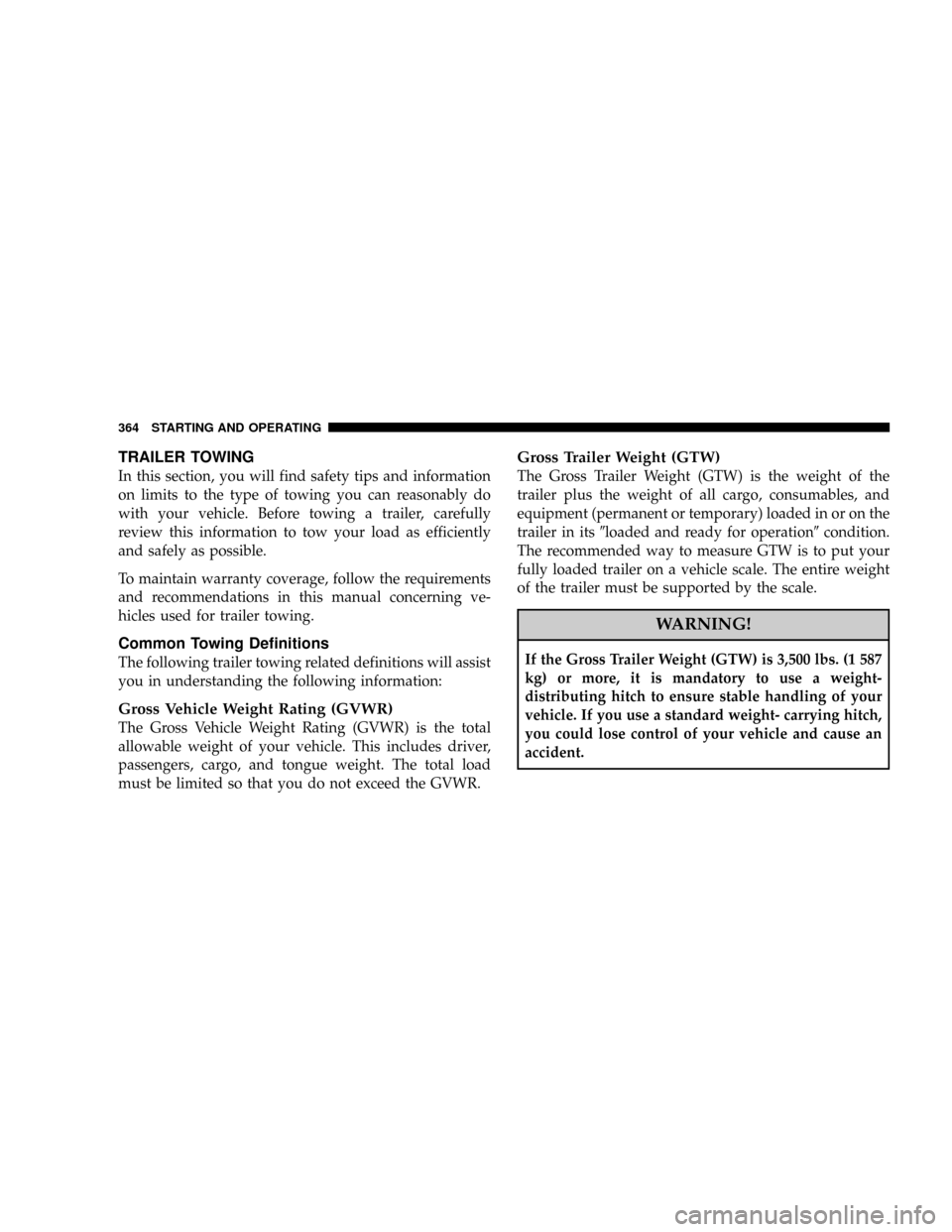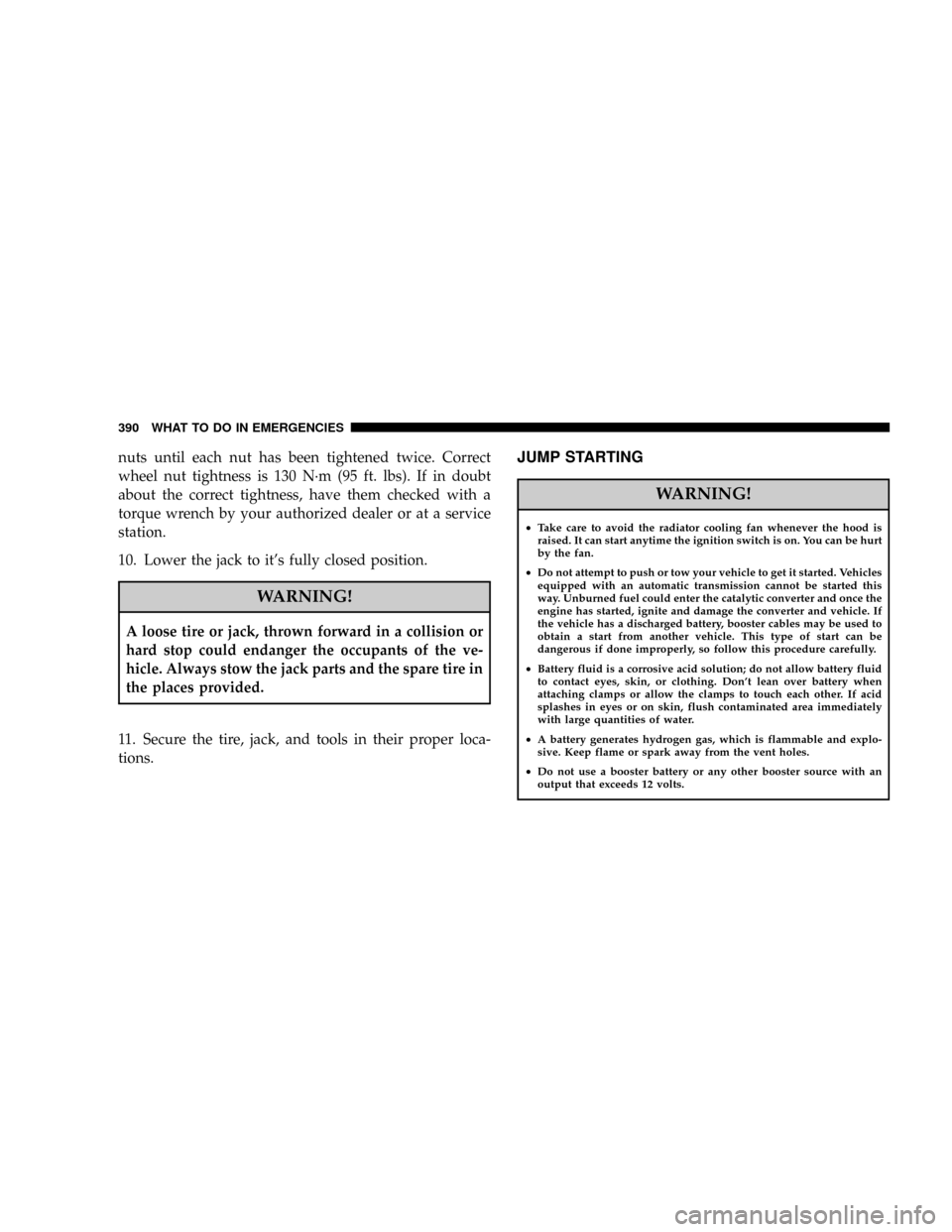2008 JEEP LIBERTY tire type
[x] Cancel search: tire typePage 347 of 493

once the system receives the updated tire pressures.
The vehicle may need to be driven for up to 10 minutes
above 15 mph (25 km/h) in order for the TPMS to
receive this information.
þFor example, your vehicle may have a recom-
mended cold (parked for more than 3 hours) placard
pressure of 33 psi (227 kPa). If the ambient tempera-
ture is 68ÉF (20ÉC) and the measured tire pressure is
28 psi (193 kPa), a temperature drop to 20ÉF (-7ÉC)
will decrease the tire pressure to approximately 24
psi (165 kPa). This tire pressure is sufficiently low
enough to turn ON the Tire Pressure Monitoring
Telltale light. Driving the vehicle may cause the tire
pressure to rise to approximately 28 psi (193 kPa),
but the Tire Pressure Monitoring Telltale Light will
still be ON. In this situation, the Tire Pressure
Monitoring Telltale Light will turn OFF only after
the tires are inflated to the vehicle's recommended
cold placard pressure value.
CAUTION!
²The TPMS has been optimized for the original
equipment tires and wheels. TPMS pressures and
warning have been established for the tire size
equipped on your vehicle. Undesirable system
operation or sensor damage may result when us-
ing replacement equipment that is not of the same
size, type, and/or style. Aftermarket wheels can
cause sensor damage. Do not use aftermarket tire
sealants or balance beads if your vehicle is
equipped with a TPMS, as damage to the sensors
may result.
²After inspecting or adjusting the tire pressure,
always reinstall the valve stem cap. This will
prevent moisture and dirt from entering the valve
stem, which could damage the Tire Pressure Moni-
toring Sensor.
STARTING AND OPERATING 347
5
Page 364 of 493

TRAILER TOWING
In this section, you will find safety tips and information
on limits to the type of towing you can reasonably do
with your vehicle. Before towing a trailer, carefully
review this information to tow your load as efficiently
and safely as possible.
To maintain warranty coverage, follow the requirements
and recommendations in this manual concerning ve-
hicles used for trailer towing.
Common Towing Definitions
The following trailer towing related definitions will assist
you in understanding the following information:
Gross Vehicle Weight Rating (GVWR)
The Gross Vehicle Weight Rating (GVWR) is the total
allowable weight of your vehicle. This includes driver,
passengers, cargo, and tongue weight. The total load
must be limited so that you do not exceed the GVWR.
Gross Trailer Weight (GTW)
The Gross Trailer Weight (GTW) is the weight of the
trailer plus the weight of all cargo, consumables, and
equipment (permanent or temporary) loaded in or on the
trailer in its9loaded and ready for operation9condition.
The recommended way to measure GTW is to put your
fully loaded trailer on a vehicle scale. The entire weight
of the trailer must be supported by the scale.
WARNING!
If the Gross Trailer Weight (GTW) is 3,500 lbs. (1 587
kg) or more, it is mandatory to use a weight-
distributing hitch to ensure stable handling of your
vehicle. If you use a standard weight- carrying hitch,
you could lose control of your vehicle and cause an
accident.
364 STARTING AND OPERATING
Page 385 of 493

JACKING AND TIRE CHANGING
WARNING!
²Getting under a jacked-up vehicle is dangerous.
The vehicle could slip off the jack and fall on you.
You could be crushed. Never get any part of your
body under a vehicle that is on a jack. If you need
to get under a raised vehicle, take it to a service
center where it can be raised on a lift.
²The jack is designed to use as a tool for changing
tires only. The jack should not be used to lift the
vehicle for service purposes. The vehicle should
be jacked on a firm level surface only. Avoid ice or
slippery areas.
Jack Location
The scissor-type jack and tire changing tools are located
in the cargo compartment behind a trim cover on the left
rear trim panel. The latch is located at the bottom of the
trim cover.
Jack Storage Location
WHAT TO DO IN EMERGENCIES 385
6
Page 390 of 493

nuts until each nut has been tightened twice. Correct
wheel nut tightness is 130 N´m (95 ft. lbs). If in doubt
about the correct tightness, have them checked with a
torque wrench by your authorized dealer or at a service
station.
10. Lower the jack to it's fully closed position.
WARNING!
A loose tire or jack, thrown forward in a collision or
hard stop could endanger the occupants of the ve-
hicle. Always stow the jack parts and the spare tire in
the places provided.
11. Secure the tire, jack, and tools in their proper loca-
tions.
JUMP STARTING
WARNING!
²Take care to avoid the radiator cooling fan whenever the hood is
raised. It can start anytime the ignition switch is on. You can be hurt
by the fan.
²Do not attempt to push or tow your vehicle to get it started. Vehicles
equipped with an automatic transmission cannot be started this
way. Unburned fuel could enter the catalytic converter and once the
engine has started, ignite and damage the converter and vehicle. If
the vehicle has a discharged battery, booster cables may be used to
obtain a start from another vehicle. This type of start can be
dangerous if done improperly, so follow this procedure carefully.
²Battery fluid is a corrosive acid solution; do not allow battery fluid
to contact eyes, skin, or clothing. Don't lean over battery when
attaching clamps or allow the clamps to touch each other. If acid
splashes in eyes or on skin, flush contaminated area immediately
with large quantities of water.
²A battery generates hydrogen gas, which is flammable and explo-
sive. Keep flame or spark away from the vent holes.
²Do not use a booster battery or any other booster source with an
output that exceeds 12 volts.
390 WHAT TO DO IN EMERGENCIES
Page 406 of 493

Drive Belts Ð Check Condition and Tension
Belt tension is controlled by means of an automatic
tensioner. Therefore, no belt tension adjustments are
required. However, belt and belt tensioner condition
should be inspected periodically and replaced if re-
quired. Improper belt tension can cause belt slippage and
failure. Low generator belt tension can cause battery
failure.
Inspect belts for evidence of cuts, cracks, glazing, or
frayed cords and replaced if there is indication of dam-
age, which could result in belt failure. Also, check belt
routing to make sure there is no interference between the
belts and other engine components. See your authorized
dealer for service.
Spark Plugs
Spark plugs must fire properly to assure engine perfor-
mance and emission control. New plugs should be in-
stalled at the specified mileage. The entire set should be
replaced if there is any malfunction due to a faulty spark
plug. Malfunctioning spark plugs can damage the cata-
lytic converter. Refer to ªFluids, Lubricants, and Genuine
Partsº in this section for the proper type of spark plug for
use in your vehicle.
Engine Air Cleaner Filter
Refer to the ªMaintenance Scheduleº in Section 8 of this
manual for engine air cleaner filter maintenance inter-
vals.
NOTE:Be sure to follow the ªdusty or off-road condi-
tionsº maintenance interval if applicable.
406 MAINTAINING YOUR VEHICLE
Page 486 of 493

Remote Keyless Entry (RKE)................. 20
Remote Sound System (Radio) Controls........ 258
Remote Starting System.................... 27
Replacement Bulbs....................... 443
Replacement Keys........................ 16
Replacement Parts....................... 402
Replacement Tires....................... 342
Reporting Safety Defects................... 463
Resetting Oil Change Indicator...........201,209
Restraint, Head......................... 122
Restraints, Child......................... 69
Restraints, Occupant...................... 41
Retractable Cargo Area Cover............... 178
Roll Over Warning........................ 4
Roof
Sky Slider Power....................164,434
Roof Type Carrier....................... 182
Rotation, Tires.......................... 345Safety Checks Inside Vehicle................. 81
Safety Checks Outside Vehicle............... 82
Safety Defects, Reporting.................. 463
Safety, Exhaust Gas....................... 80
Safety Information, Tire................... 329
Safety Tips............................. 79
Satellite Radio....................237,239,254
Satellite Radio Antenna................... 255
Schedule, Maintenance.................... 452
Seat Belt Maintenance.................... 433
Seat Belt Reminder....................... 48
Seat Belts............................42,81
Adjustable Upper Shoulder Anchorage........ 46
And Pregnant Women................... 50
Child Restraint.......................69,76
Extender............................. 51
Front Seat............................ 42
Inspection............................ 81
Pretensioners.......................... 47
486 INDEX
Page 493 of 493

INTRODUCTION INTRODUCTION ROLLOVER WARNING HOW TO USE THIS MANUAL WARNINGS AND CAUTIONS VEHICLE IDENTIFICATION NUMBER VEHICLE MODIFICATIONS / ALTERATIONS THINGS TO KNOW BEFORE STARTING YOUR VEHICLE A
WORD ABOUT YOUR KEYS Ignition Key RemovalKey-In-Ignition ReminderSENTRY KEY Replacement KeysCustomer Key ProgrammingGeneral InformationSTEERING WHEEL LOCK - IF EQUIPPED To Manually Lock the Steering WheelTo Release the Steering Wheel
LockSECURITY ALARM SYSTEM - IF EQUIPPED Rearming of the SystemTo Arm the SystemTo Disarm the SystemILLUMINATED ENTRY SYSTEM REMOTE KEYLESS ENTRY To Unlock the Doors and LiftgateTo Lock the Doors and LiftgateTo Unlatch the Liftgate Flip-Up
WindowUsing the Panic AlarmProgramming Additional TransmittersBattery ReplacementGeneral InformationREMOTE STARTING SYSTEM - IF EQUIPPED HowTo Use Remote StartDOOR LOCKS Manual Door LocksPower Door LocksChild-Protection Door Lock System
(Rear Doors)WINDOWS Power WindowsWind BuffetingLIFTGATE OCCUPANT RESTRAINTS Lap/Shoulder BeltsLap/Shoulder Belt Untwisting ProcedureSeat Belt PretensionersEnhanced Seat Belt Use Reminder System (BeltAlert)Automatic Locking Mode - If Equipped
Energy Management FeatureSeat Belts and Pregnant WomenSeat Belt ExtenderDriver and Front Passenger Supplemental Restraint System (SRS) - AirbagChild RestraintENGINE BREAK-IN RECOMMENDATIONS SAFETY TIPS Transporting PassengersLock Your Vehicle
Exhaust GasSafety Checks You Should Make Inside The VehiclePeriodic Safety Checks You Should Make Outside The VehicleUNDERSTANDING THE FEATURES OFYOUR VEHICLE MIRRORS Inside Day/Night MirrorAutomatic Dimming Mirror - If EquippedOutside
MirrorsExterior Mirrors Folding Feature - If EquippedPower Remote Control MirrorsHeated Remote Control Mirrors - If EquippedIlluminated Vanity Mirrors - If EquippedHANDS-FREE COMMUNICATION (UConnect) - IF EQUIPPED OperationPhone Call FeaturesUConnect
System FeaturesAdvanced Phone ConnectivityThings You Should Know About Your UConnect SystemGeneral InformationSEATS Manual Front Seat AdjustmentsPower Seat - If EquippedHead RestraintsHeated Seats - If Equipped60/40 Split Folding Rear Seat with Fold
Flat FeatureDRIVER MEMORY SEAT - IF EQUIPPED Programming The Memory FeatureLinking and Unlinking the Remote Keyless (RKE) Transmitter to the MemoryFeatureMemory Position RecallEasy Entry/Exit Seat (Available with Memory Seat Only)TO OPEN AND
CLOSE THE HOOD LIGHTS Exterior and Interior Lighting ControlHeadlights and Parking LightsAutomatic Headlights - If EquippedHeadlights with Wipers (Available with Auto Headlights Only)Headlight Time Delay - If EquippedDaytime Running Lights (DRL) - If Equipped
Lights-On ReminderFog Lights - If EquippedTurn SignalsHighbeam/Lowbeam Select SwitchFlash to PassInterior LightsWINDSHIELD WIPERS AND WASHERSIntermittent Wiper SystemMist FeatureHeadlights with Wipers (Available with Auto Headlights Only)Rain Sensing
Wipers - If EquippedWindshield WashersAdding Washer FluidTILT STEERING COLUMN ELECTRONIC SPEED CONTROL - IF EQUIPPED Electronic Speed Control OperationTo ActivateTo Set At A Desired SpeedTo DeactivateTo Resume SpeedTo Vary The Speed Setting
To Accelerate For PassingREAR PARK ASSIST SYSTEM - IF EQUIPPED System Usage PrecautionsEnabling and Disabling the SystemSystem OperationGARAGE DOOR OPENER - IF EQUIPPED Programming HomeLinkGate Operator/Canadian ProgrammingUsing
HomeLinkReprogramming a Single HomeLink ButtonSecurityTroubleshooting TipsGeneral InformationPOWER SUNROOF - IF EQUIPPED Opening Sunroof - ExpressClosing Sunroof - ExpressPinch Protect FeaturePinch Protect OverrideVenting Sunroof - ExpressSunshade
OperationWind BuffetingSunroof MaintenanceIgnition Off OperationSKY SLIDER FULL LENGTH OPEN ROOF Sky Slider Usage PrecautionsPower Top ControlOpening the Sky SliderClosing the Sky SliderAnti-Pinch Protect FeatureWind BuffetingSky Slider Maintenance
ELECTRICAL POWER OUTLET Electrical Outlet Use With Engine OffPOWER INVERTER - If EQUIPPED CUP HOLDERS STORAGE Front Storage CompartmentConsole Storage CompartmentCARGO AREA FEATURES Cargo Load FloorREAR WINDOW FEATURES
Rear Window Wiper/Washer - If EquippedRear Window Defroster - If EquippedROOF LUGGAGE RACK - IF EQUIPPED INSTRUMENT PANEL AND CONTROLS INSTRUMENT PANEL FEATURES INSTRUMENT CLUSTER INSTRUMENT CLUSTER DESCRIPTIONS
ELECTRONIC VEHICLE INFORMATION CENTER (EVIC) - IF EQUIPPED Electronic Vehicle Information Center (EVIC) DisplaysOil Change RequiredTrip FunctionsCompass DisplayTelephone (UConnect) - If EquippedPersonal Settings (Customer Programmable Features)
RADIO GENERAL INFORMATION Radio Broadcast SignalsTwo Types of SignalsElectrical DisturbancesAM ReceptionFM ReceptionSALES CODE REQ - AM/FM STEREO RADIO AND 6-DISC CD/DVD CHANGER (MP3/WMA AUX JACK) Operating Instructions - Radio
ModeOperation Instructions - (DISC MODE for CD and MP3/WMA Audio Play, DVD-VIDEO)Notes On Playing MP3/WMA FilesLIST Button (DISC Mode for MP3/WMA Play)INFO Button (DISC Mode for MP3/WMA Play)SALES CODE RER - MULTIMEDIA SYSTEM - IF
EQUIPPED Operating Instructions - Satellite RadioOperating Instructions - Hands-Free Communication (UConnect) (If Equipped)Clock Setting ProcedureSALES CODE RES - AM/FM STEREO RADIO WITH CD PLAYER (MP3 AUX JACK) Operating Instructions - Radio
ModeOperation Instructions - CD MODE for CD and MP3 Audio PlayNotes On Playing MP3 FilesLIST Button (CD Mode for MP3 Play)INFO Button (CD Mode for MP3 Play)SATELLITE RADIO (RSC) - IF EQUIPPED (RER/REQ/REN RADIOS ONLY) System Activation
Electronic Serial Number/Sirius Identification Number (ENS/SID)Selecting Satellite ModeSatellite AntennaReception QualityOperating Instructions - Satellite ModeOperating Instructions - Hands Free Phone (If Equipped)Operating Instructions - Video Entertainment System
(VES) (If Equipped)REMOTE SOUND SYSTEM CONTROLS - IF EQUIPPED Right-Hand Switch FunctionsLeft-Hand Switch Functions for Radio OperationLeft-Hand Switch Functions for Media (i.e. CD) OperationCD/DVD DISC MAINTENANCE CLIMATE CONTROLS
Manual Air Conditioning and Heating System Automatic Temperature Control (ATC) - If Equipped Operating TipsSTARTING AND OPERATING STARTING PROCEDURES Automatic TransmissionManual Transmission - If EquippedNormal StartingExtreme Cold Weather
(below -20 degrees F or -29 degrees C)If Engine Fails to StartAfter StartingENGINE BLOCK HEATER - IF EQUIPPED AUTOMATIC TRANSMISSION Shift Lock Manual Override - If EquippedBrake/Transmission Interlock System4-Speed Automatic TransmissionMANUAL
TRANSMISSION - IF EQUIPPED Clutch Interlocking Ignition System6-Speed Manual TransmissionFOUR-WHEEL DRIVE OPERATION MP1522 Command-Trac Transfer Case - If EquippedMP3022 Selec-Trac II Transfer Case - If EquippedON-ROAD DRIVING TIPS
OFF-ROAD DRIVING TIPS When To Use 4WD Low RangeDriving Through WaterDriving In Snow, Mud and SandHill ClimbingTraction DownhillAfter Driving Off-RoadPARKING BRAKE ANTI-LOCK BRAKE SYSTEM POWER STEERING ELECTRONIC BRAKE CONTROL
SYSTEM ABS (Anti-Lock Brake System)TCS (Traction Control System)BAS (Brake Assist System)ERM (Electronic Roll Mitigation)TSC (Trailer Sway Control) - If EquippedHSA (Hill Start Assist)HDC (Hill Descent Control) - If EquippedESP (Electronic Stability Program)
ESP/BAS Warning Light and ESP/TCS Indicator LightTIRE SAFETY INFORMATION Tire Markings Tire Identification Number (TIN)Tire Loading and Tire PressureTIRES - GENERAL INFORMATION Tire PressureTire Inflation PressuresTire Pressures for High Speed
OperationRadial-Ply TiresTire SpinningTread Wear IndicatorsLife of TireReplacement TiresAlignment and BalanceTIRE CHAINS TIRE ROTATION RECOMMENDATIONS TIRE PRESSURE MONITOR SYSTEM (TPMS) - IF EQUIPPED Base System - If EquippedPremium
System - If EquippedGeneral InformationFUEL REQUIREMENTS Reformulated GasolineGasoline/Oxygenate BlendsMMT In GasolineMaterials Added to FuelFuel System CautionsCarbon Monoxide WarningsADDING FUEL Fuel Filler Cap (Gas Cap)Loose Fuel Filler Cap
MessageVEHICLE LOADING Certification LabelTRAILER TOWING Common Towing DefinitionsTrailer Hitch ClassificationTrailer Towing Weights (Maximum Trailer Weight Ratings)Trailer and Tongue WeightTowing RequirementsTowing TipsRECREATIONAL TOWING
(BEHIND MOTORHOME, ETC.) Towing - 2WD ModelsTowing - 4WD ModelsWHAT TO DO IN EMERGENCIES IF YOUR ENGINE OVERHEATS JACKING AND TIRE CHANGING Jack LocationSpare Tire StowageSpare Tire RemovalPreparations For JackingJacking
InstructionsJUMP STARTING TOWING A DISABLED VEHICLE MAINTAINING YOUR VEHICLE 3.7L ENGINE COMPARTMENT ONBOARD DIAGNOSTIC SYSTEM - OBD II Loose FuelFiller Cap MessageEMISSIONS INSPECTION AND MAINTENANCE PROGRAMS
REPLACEMENT PARTS DEALER SERVICE MAINTENANCE PROCEDURES Engine OilEngine Oil FilterDrive Belts - Check Condition and TensionSpark PlugsEngine Air Cleaner FilterFuel FilterCatalytic ConverterCrankcase Emission Control SystemMaintenance-Free
BatteryAir Conditioner MaintenanceA/C Air Filter - If EquippedPower Steering - Fluid CheckDriveline and Steering Component LubricationBody LubricationWindshield Wiper BladesWindshield and Rear Window WashersExhaust SystemCooling SystemHoses and
Vacuum/Vapor HarnessesFuel SystemBrake SystemClutch Hydraulic System - Manual Transmission (If Equipped)Automatic TransmissionManual Transmission - If EquippedTransfer CaseFront/Rear Axle FluidAppearance Care And Protection From CorrosionSKY SLIDER
TOP CARE WashingGeneral CleaningAdditional Cleaning ProcedureProtectionWeather Strip CareFUSES (INTEGRATED POWER MODULE) REPLACEMENT LIGHT BULBS BULB REPLACEMENT HeadlightFront Turn Signal and Front Side Marker LightsFront Fog Light
Rear Tail/Stop, Turn Signal, and Back-Up LightsFLUID CAPACITIES FLUIDS, LUBRICANTS, AND GENUINE PARTS EngineChassisMAINTENANCE SCHEDULES EMISSION CONTROL SYSTEM MAINTENANCE MAINTENANCE SCHEDULE Required Maintenance
IntervalsIF YOU NEED CONSUMER ASSISTANCE SUGGESTIONS FOR OBTAINING SERVICE FOR YOUR VEHICLE Prepare For The AppointmentPrepare A ListBe Reasonable With RequestsIF YOU NEED ASSISTANCE WARRANTY INFORMATION (U.S. Vehicles
Only) MOPAR PARTS REPORTING SAFETY DEFECTS In CanadaPUBLICATION ORDER FORMS DEPARTMENT OF TRANSPORTATION UNIFORM TIRE QUALITY GRADES TreadwearTraction GradesTemperature GradesINDEX